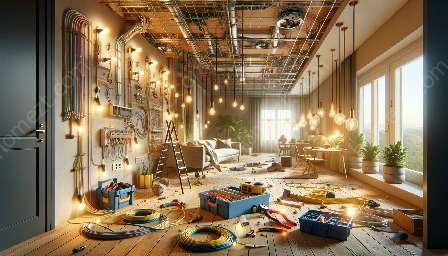Lighting design plays a crucial role in creating an attractive and functional space. By integrating principles of lighting design with electrical wiring and home improvement, you can enhance the aesthetics and functionality of any environment.
The Importance of Lighting Design
Lighting design is not just about providing illumination; it is also an essential element of interior and exterior design. Effective lighting design can transform the mood and ambiance of a space, improving the overall aesthetics and functionality. It is important to consider the principles of lighting design when planning and executing any lighting project.
Principles of Lighting Design
Understanding the principles of lighting design is essential in creating visually appealing and functional lighting solutions. Key principles include:
- 1. Functionality: Lighting should first and foremost serve its intended purpose, whether it is ambient, task, or accent lighting. Understanding the specific needs of each space is crucial in determining the appropriate lighting solution.
- 2. Balance: Achieving a balanced lighting scheme involves considering the distribution of light throughout a space. Balancing light and shadow helps create a visually pleasing environment.
- 3. Contrast: Contrast adds visual interest to a space, emphasizing different focal points and creating depth. Understanding how to use contrast effectively can enhance the aesthetics and functionality of a room.
- 4. Color Temperature: The color temperature of light can significantly impact the mood and feel of a space. Warm and cool color temperatures can evoke different emotional responses and should be carefully considered in the design process.
Aesthetics in Lighting Design
While functionality is essential, aesthetics also play a crucial role in lighting design. Aesthetic considerations in lighting design include:
- 1. Visual Appeal: The visual appeal of lighting fixtures and their integration into the overall design scheme can greatly impact the aesthetics of a space. Selecting fixtures that complement the design style and color scheme is important in creating a cohesive look.
- 2. Mood and Atmosphere: Lighting can be used to set the mood and atmosphere of a space, from creating a cozy and intimate setting to a bright and lively environment. Understanding how to use lighting to convey a desired atmosphere is key in achieving the intended aesthetic.
- 3. Focal Points: Proper lighting design can draw attention to specific features or focal points within a room, enhancing the overall aesthetic appeal of the space.
- 1. Planning and Coordination: When undergoing home improvement projects that involve electrical wiring, it is important to consider the lighting design early in the planning phase. Coordination between the wiring layout and lighting fixtures is essential for a cohesive and functional result.
- 2. Energy Efficiency: Utilizing modern lighting technologies and energy-efficient fixtures can not only enhance the aesthetics of a space but also contribute to cost savings and environmental sustainability.
- 3. Safety and Code Compliance: Ensuring that lighting fixtures and electrical wiring meet safety standards and local building codes is crucial in any home improvement project. Proper installation and adherence to codes are essential for creating a safe and functional environment.
Compatibility with Electrical Wiring and Home Improvement
Incorporating lighting design principles into the planning and execution of electrical wiring and home improvement projects can greatly enhance the overall outcome. Factors to consider include:
Conclusion
By understanding the principles of lighting design and integrating them with electrical wiring and home improvement projects, you can create visually appealing, functional, and safe environments. Whether it's enhancing the aesthetic appeal of a room or improving the overall functionality of a space, lighting design principles play a critical role in achieving successful outcomes.


